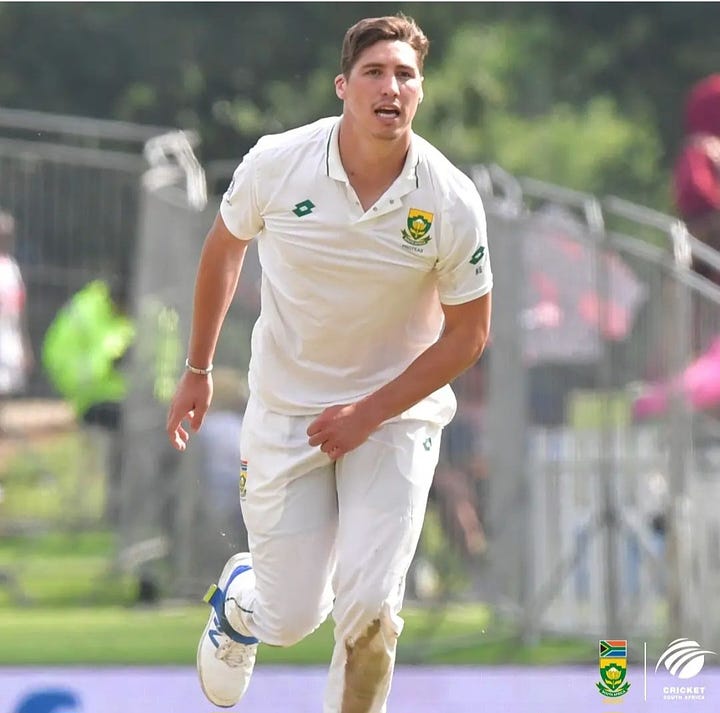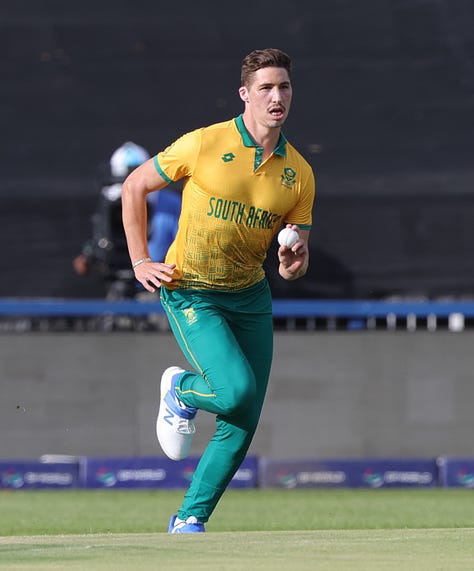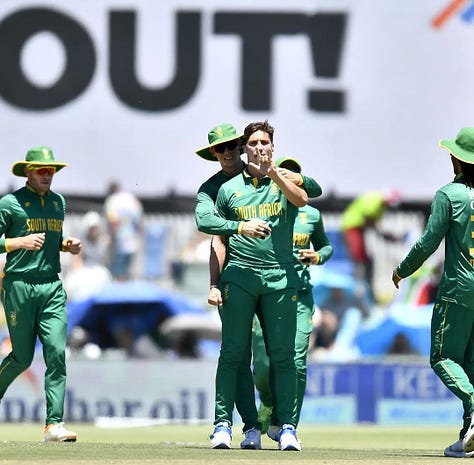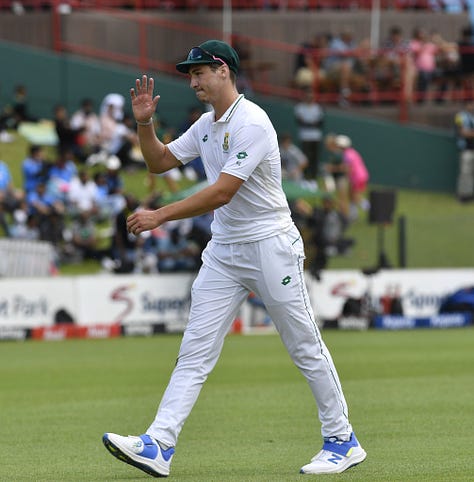The Accidental Cricketer
Nandre Burger had no intention of becoming a professional cricketer, then he became one
On the 19th of December 2023, Nandre Burger bowled his first one-day international delivery. It went for four. He pulled the length back on the second one enough to deny Rituraj Gaikwad the drive. The ball pitched on middle and leg and swung past the inside edge. Take away the batter, and it would have cannoned into leg stump. But, Gaikwad was there and it smashed onto his pads. Burger had his maiden ODI wicket.
Seven days later, his 10th delivery in Test cricket earned him his maiden Test wicket. The ball pitched up and outside off, and swung away from Yashasvi Jaiswal a bit outside off. The left-hander loosely drove at it and nicked it behind to the keeper.
Burger can swing the ball at high pace, has nudged the speed gun to the 150kph-mark already so far in his short international career, possesses a good bouncer, has mastered the knuckle-ball delivery and has a toe-crunching yorker as part of his arsenal. His height also allows him to get some extra bounce.


In 2014, the idea that Nandre Burger would play for the Proteas sounded ridiculous. He didn’t even think he could make a career out of cricket. Between 90 and 95 per cent of youngsters who become professional cricket know their path before they turn 13, and they pursue that dream relentlessly. Graeme Smith knew his destiny when he placed his famous "I will be captain of my country" note under a fridge magnet when he was 12. Nandre Burger was none of those kids.
At 13, Burger had ambitions of playing on the ATP tour and was working on his serve. By the time was 14, he possessed an Albano Olivetti-type of monster serve. Burger could first-serve opponents out of the match and he was developing his all-round game with the help of his coaches and YouTube, where he watched countless videos of Roger Federer. That dream came crashing down when he was 15.
“There was something wrong with my serve and I developed back spasms because of it. The people around me told me that I would need to remodel my serve if I wanted to keep going and it would take about two years before I was at my best again. It felt like I had wasted five years,” says Burger.
He didn’t have the strength to go through the remodelling, so he moved on from tennis. For a brief moment, Burger considered replacing tennis with squash, then decided against it. He reasoned that it would be tough for him to make a living off the sport. With dreams of a career as a professional sportsperson buried, he began spending more time at club cricket.
Cricket had always been in the picture. In their backyard, there was a wall where Burger spent countless hours with his racket practising his volleying against, during the cricket season he would convert a section of that wall into a set of stumps and do target bowling. When he met up with his friends, he channelled his inner Dale Steyn and launched the fastest missiles his spindly arms could manage.
When he was younger, Burger was that kid who pretended to be Dale Steyn when he bowled to his mates and that dream died the moment he left the field. At club cricket, he played for the enjoyment and social element.
This newsletter is 100% reader-supported. If you’re willing and able, please consider supporting it in one of two ways, leaving a tip or becoming a Patreon. Thank you so much for your time and investment!
In 2014, Nandre Burger found himself at the Wits University nets, bowling under Neil Levenson’s watchful gaze. He was there because his father had more faith in his potential than he did and had reached out to Levenson to see if he could attend the trials. Burger had no illusions as he walked into the nets, the highest level he had reached in age group cricket was Gauteng Under-17 B. “I only went to the trials because it was an opportunity for me to play some cricket while I studied for my sports psychology degree,” says Burger.
One of the first things Levenson noted was that Burger’s homespun technique limited what he could do with the ball. Unlike tennis, Monument High School did not have an experienced cricket coach or a reputable cricket program, so Burger did not have anyone to set him on the right path. “I would watch Dale Steyn and a couple of other fast bowlers, and try to copy them. With time, I developed a technique that was a mishmash of what I tried to copy,” says Burger.
He was technically raw, to use Levenson's words. Most coaches would have passed up on taking him on, but Levenson is not like most coaches. "If a player has 12 bad qualities and three good ones, Neil will use those three to overcome the 12. He sees the best in players," says Burger.
The rawness aside, Burger had the physical attributes that made for a good bowler. He just didn't know how to do it efficiently. Levenson's job was to teach him that. “He clocked around 127, 128, which are good enough speeds for a club bowler. But, watching him, I felt that there was a lot more left in him. I felt that he could be much more than he presented,” says Levenson.
Levenson was also impressed by Burger’s attitude. Burger gave his all in every delivery he bowled. It didn’t matter that the deliveries were wayward, he bowled each one as if he expected it to do something special. After his train wreck of a trial net session, Levenson shocked Burger by inviting him back. The 19-year-old had earned himself a spot on the team and a bursary. “He showed good character, and you could see that the talent was there. He just needed nurturing and guidance,” says Levenson.



“In our first session, Neil said to me, ‘You could play professional cricket and bowl at 140kph’,” says Burger, who stared at his mentor with a look of studied scepticism. 140kph was close to 15kph quicker than his speed at the time. It sounded unattainable. And the idea that he could be a professional cricketer? Burger didn’t spend much time thinking about it.
The training sessions were split into two sessions, conversation and training. Close to half of the session was spent discussing the part of his bowling action they were working on that particular day. “I wanted him to understand what the action was and why it mattered. It’s always easy to move forward when a player completely understands and has a mental picture,” says Levenson.
They had to get the principles in place. The first thing they did was work on Burger’s gather. If Burger was going to be effective as a bowler, he needed to be efficient with his action. Then they worked on his alignment in the crease and angles of his run-up. “We also cleaned up his action’s Biomechanics and timing, before we moved on to his gather and snap,” says Levenson.
They also worked on ensuring that he had a soft backfoot landing. After the backfoot was sorted, they worked on Burger’s front-foot heel contact. If a bowler lands on their toes, they won’t be able to brace their front leg, which would lead them to lose momentum. Then there was the chest drive and hip/shoulder separation.
After the fundamentals were locked in Burger’s mind, it was time to make them second nature. There were days when Burger’s training was focused on him walking through the action. On some days he walked through the action blindfolded and on others he did stationary bowling. They also did barefoot bowling, which Burger did not like. Levenson insisted on it, despite Burger’s protests. “He said it would help me to get me to feel what it feels like, the real feel of bowling with the right action,” says Burger.
In 2018, the NBA and USA Basketball assembled a group of leading experts to share their applied research and practices in developing elite athletes. The report from the experts noted that a variable sporting childhood can accelerate skill development. ‘By specializing later, athletes acquire a multifaceted repertoire in terms of a wider and closer-meshed network of perceptual motor skills, which facilitates the emergence of functional skill solutions.’
By specializing in cricket much later than his contemporaries, Burger joined the league of athletes like Helen Glover, who won an Olympic gold medal at 26, five years after picking up rowing as a sport, and Mark Cueto. Cueto did not play rugby union between the ages of 10 and 17 but went on to earn 55 caps for England’s senior team.
Like Glover, Cueto and other athletes who specialised late, Burger immersed himself in the art of bowling when he warmed up to the idea of pursuing a career as a cricketer. He spent more than six hours training each day. He trained with Enoch Nkwe at the Gauteng Strikers, with the Wits squad and then had one-on-one sessions with Levenson. When he wasn’t training, he watched videos and read whatever he could find.
It took about six months of daily training before the first results were visible. By then, his action was cleaner and smoother. After a year, Burger had reached the 130kph mark on the speed gun. After two years he reached 135kph. The first thing he did after getting off the field was text Levenson.
That is their tradition, each time Burger reaches a new milestone, he texts Levenson. He did so when he bowled a 140kph delivery, then a 145kph ball. Each time, Levenson celebrates the achievement and then they set a new goal. The first goal is to reach a speed and then bowl consistently at it, before aiming for a higher speed. “Nandre can be one the best quick bowlers in the world and that is what we are working on,” says Levenson.
Unlike their Wits University days, Burger and Levenson have little to no physical contact over periods of a month or more. Burger is based in Cape Town, where he plays for Western Province, and Levenson is with the North West Dragons in Potchefstroom. Coach and student call each other a lot and Burger constantly sends video footage of himself in training for Levenson’s feedback.
“He always pushes me to improve. He will review the videos and tell me, your shoulder or hip is not turning enough, or something like that,” says Burger.
The duo doesn’t focus on how many wickets Burger can take. Wickets are the outcome. They prefer to focus on the process; on whether Burger is doing the basics right and generating higher speeds. If you execute the fundamentals, the outcome will take care of itself.
Once you let go of the ball, you can’t do anything about it. Just follow the follow the process, Levenson always tells Burger. The approach has produced results in the eight years that they have worked together. After his ODI and Test cricket maiden wickets, Burger and Levenson have a new milestone, consistently get to 150kph.
If you found this interesting, please share it:
You can support Stumped! by leaving a tip:
Thanks for reading. Until next time… - CS





Another great piece CS, thanks! That’s exactly the sort of insight into Nandre Burger that I was looking for when watching the first Test on Supersport. Unless I missed it, the commentators offered very little on Burger's background, why he was a late bloomer, and so on. I hope they read this and can share the backstory with viewers during the second Test.